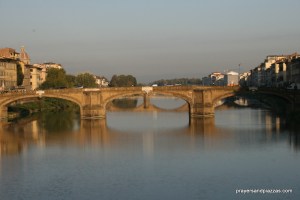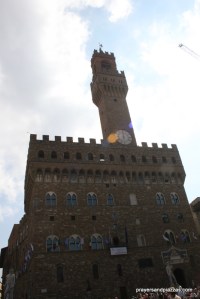This time last year I found myself waking up in Florence — strange for a Southern California resident — the chimes of the Duomo’s bells drifting through my open window. For me, every morning in Italy feels full of opportunity and ripe with undiscovered memories. But this particular morning promised a once-in-a-lifetime gift. On a whim, I had run away to Florence to walk in the footsteps of Mona Lisa with Dianne Hales, the author who brought the iconic donna (woman) to life for me in the acclaimed book MONA LISA: A Life Discovered.
A gentle rainstorm the day before had washed the city clean, and this jewel of the Renaissance sparkled under the crystal blue sky that October morning. Walking through the cobblestone streets which smell of leather, I am humbled to think about how many other rock stars of history have wandered this same path. Evidence of this is everywhere you turn. But nothing which indicates that Mona Lisa was ever here.
“Florence’s most famous daughter is virtually invisible in her hometown,” writes Dianne. “No plaques commemorate where she lived; no monuments or streets bear her name. Yet a genius immortalized her…Hers was the city that thrills us still, home to larger-than-legend figures such as Leonardo, Michelangelo, and Machiavelli. But all that remains of Lisa is her smile.”
~ ~ ~
On June 15, 1479, Lisa Gherardini was born in wool shop-turned-house on narrow Via Squazza (“wallow”) in the section of Florence known as the Oltrarno (beyond the River Arno). Still a lively and vibrant quarter, to get to there and to the starting point of the tour I crossed the beloved Ponte Vecchio, the only of Florence’s bridges to survive WWII. Traversing the bridge, I think about how Lisa herself must have crossed over these same cobbled stones hundreds of times.
“Graffiti smear the grimy houses that line the dank street. Trash huddles in corners. Wooden doors splinter and sag on rusty hinges. No one lingers in the gloom. No one seems to care about a girl named Lisa Gherardini born centuries ago amid the clattering mills of Florence’s cloth trade. Unexpectedly, I find that I do.” writes Dianne.
Above: Via Squazza is shadowed, smelly, and eerily silent. We are the only people on the street, our little tour group. Lisa was born of a noble and ancient family, but their status had diminished by the time she was born.
Below: My photo, which I believe is the door of Lisa’s birthplace. But since it’s been a year and I am notorious for taking pictures of doors in Italy, I can’t be certain. (Note to self: try to write posts in a more timely fashion as was the original intent!)

Next, we cross over (attraversiamo) the picturesque beauty below, Ponte Santa Trinità, which was built in the late 1500s and reconstructed after WWII with stones recovered from the Arno. We arrive in the piazza of the church for which the bridge is named.
Meandering through smaller and less crowded streets (strade meno affolate), we soon reach Piazza della Signoria, then and now, the civic center of Florence. Lisa’s much older husband, the cantankerous but successful silk merchant Francesco del Giocondo, served the Florentine government here in the early 1500s.
Above: This was my fourth visit to Florence but the first time that I stepped foot inside the Palazzo Vecchio. The first floor is free, although paying for an entrance ticket to the higher floors is extremely worth it.

Piazza della Signoria Image Credit
A short walk down Via Calzaiuoli (the “street of the little wool sock makers”) and past my hotel (Hotel Calzaiuoli – highly recommended) one is greeted by the majestic Duomo, the engineering marvel of Filippo Brunelleschi which has watched over Florence since 1436. Il mio cuore batte velocemente ogni volta — my heart beats rapidly every time. (My own translation of be still my beating heart.)
Likely the most famous and recognizable landmark of Florence, above is the cupola of Santa Maria del Fiore, but the Battistero di San Giovanni below is really more important to Florentines. “The Italian poet Dante and many other notable Renaissance figures, including members of the Medici family, were baptized in this baptistery.” Wikipedia “In fact, until the end of the nineteenth century, all Catholic Florentines were baptized here,” including Lisa Gherardini on June 15, 1479, the day of her birth.

Far too soon for me, we find ourselves just a few blocks from Piazza del Duomo and on Via della Stufa, where Lisa lived out her married life in comfort and status, and raised her children. This pleasant street is almost literally in the backyard of Florence’s most renowned family, the Medicis.
Above: Cappelle Medici (Medici Chapels) and the Palazzo Medici Riccardini (the Medici family home) cast their shadows on Via della Stufa. While touring this area the day before on my own, I had passed by Via della Stufa without even noticing.
Below: Via della Stufa – of this door I am certain – restored since Lisa’s time but home of the Giocando family. Still today, this street is bright and inviting, but surprisingly quiet given its proximity to all things Medici.
Perpendicular to Via della Stufa is Sant’Orsola, the ruined eyesore which was the convent where the widowed Lisa, lived out her last years. For me, this final stop was most touching of all. Once a prestigious convent in Florence, Sant’Orsola housed 60 nuns at a time and throughout the years, hundreds of young Florentine women training to take their vows, including Lisa’s daughter. Widows of status could also choose to live out there days within Sant’Orsola’s walls, which is what Lisa did.
“Lisa’s mortal remains should lie [in the Basilica of Santissima Annunziata] with her husband’s, but she defied his wishes and chose a different resting place: the Monastero di Sant’Orsola, just a short block from her home on Via della Stufa,” writes Dianne. “I credit Lisa’s independent Gherardini spirit, which led her to end her days where she wanted — in a house of God, near her beloved daughter, sheltered from the cataclysms that had so often convulsed her city. She never left.”
In a city glittering with Renaissance treasures, Sant’Orsola’s sheer ugliness is, in my opinion, unacceptable and heartbreaking. Still, the tour ends and my heart is full, from seeing a city I love through the eyes of the woman behind the most recognizable smile in all of history, with the author who captured Lisa’s humanity with eloquence.

Lisa from Florence — daughter, wife, mother — who possibly never saw her infamous portrait finished. Lisa from Florence, who likely had no idea that she would be known the world over and centuries after her death as Mona Lisa. Lisa from Florence, in Dianne’s words, “una donna vera (a real woman).”
Stacy di Anna with Dianne Hales. ❤ A great start to an unforgettable day.
This post first appeared on Prayers and Piazzas in October 2015. For more on the Mona Lisa walking tours, click here. For more on Mona Lisa in Dianne’s words, click here and here.









Reblogged this on Make Italy Yours.
Molto interessante!
You are conjuring up some beautiful memories of a time that’s too far past. I feel it calling me back…soon 🙂
Indeed. Florence waits for you! ❤
I’ve nominated you for the Liebster Award, which you can read about here: https://jhaneellockhart.com/2016/06/15/getting-to-know-me-a-blogging-award/
No pressure to post about this on your blog, although I would love to read your answer to the questions. 🙂
Wow, thank you for the nomination! I’m honored!